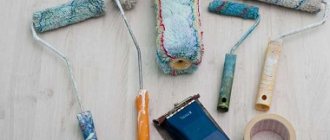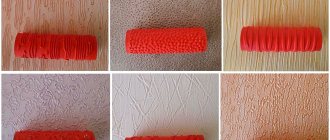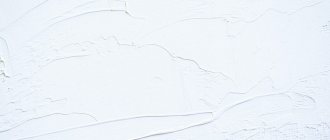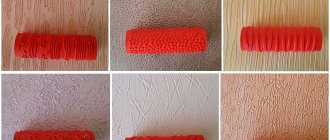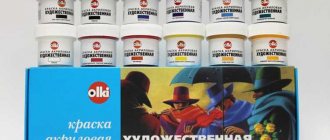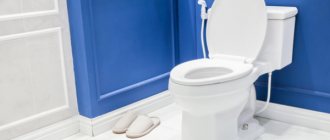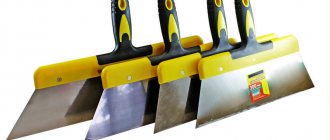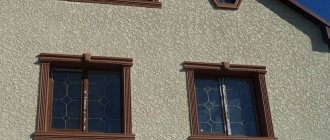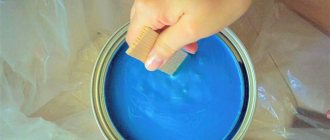Wall dissolver for the production of paints and varnishes with fastenings to walls or columns. Low price!
Structural paint is an excellent finishing material, which has recently been actively used in renovations along with wallpaper and other finishing materials. Its application is quite simple and does not require any professional skills, however, you should still familiarize yourself with some of the nuances of the work.
Therefore, next we will look at the main features of this paint and the technology for decorating walls with it yourself.
Surface painted with structure paint
What is structural paint
First of all, let's figure out what structural or, as it is also called, textured paint is. So, externally, it is a thick and viscous white mass. Despite the fact that the material is called paint, its structure is more reminiscent of plaster .
After applying this composition to the wall, it is given a certain structure using a roller or other tools.
Structural paint Ceresit
Advantages of coverage
It must be said that the growing popularity of this finishing material is fully justified by its many advantages:
- The coating has good vapor permeability, so the natural moisture exchange in the room is not disturbed.
- The dense structure of the coating allows you to hide minor flaws in the rough finishing of the walls, so there is no need to bring the base to perfect condition.
- Since structural plaster is initially white, it can be given any desired shade using special colors.
- The coating has high moisture resistance, so the material can be used in rooms with high humidity levels. And if the walls become dirty, they can be cleaned using water without fear of damaging the surface.
- High wear resistance.
- Resistant to ultraviolet rays.
- Elasticity.
- Environmentally friendly and harmless in the process of painting surfaces.
- If necessary, you can change the color of the finish at any time by covering it with acrylic paint.
- Versatility - the coating can be used not only indoors, but also outdoors. The paint can be applied to concrete, brick, plasterboard, plastered and putty surfaces.
Advice! When painting the composition, it is advisable to use a color from the same manufacturer as the texture paint itself. This will allow you to get the best quality result.
Color for structural paint
Flaws
The only disadvantage of the material can be noted that its price is quite high. However, given the durability of such a finish and its wear resistance, the end result is still savings.
Which decorative roller for walls to buy: types of coats
The coat is perhaps the most important criterion for choosing a roller for painting walls and ceilings. After all, the final result and appearance of the surface depend on this. Therefore, it is worth considering what types of roller coats there are:
- Rubber rollers are made of soft or hard rubber. Often, such tools have a pronounced texture and are used to give plaster relief, as well as to apply a pattern to wallpaper or a painted surface.
- polyamide - made of synthetic fiber, which is characterized by extremely high wear resistance. At the same time, on sale you can find options with different pile lengths, which can range from 8 to 20 mm. These rollers are ideal for working with water-based paints;
A decorative rubber roller can have different textures, with which you can create interesting designs and ornaments on the wall
a fur coat made of natural fur, which is most often sheepskin. This option is also ideal for working with water-based paint, as well as oil-based and various varnish compositions. Obviously, the price of a paint roller with such a coat will be higher than all others; A velor roller is usually used if it is necessary to apply a finishing layer of coating. Alkyd enamels and oil paints are best suited for this purpose; A polyacrylic paint roller is similar to a polyamide one. It is characterized by high resistance to aggressive components of the composition, and therefore is suitable for working with any paint; foam rubber is another material widely used for making rollers
But when working with it, you need to be careful, and among all the compositions it is only suitable for water-dispersion paints. When painting the surface, do not apply too much pressure, as this may cause drips.
But the speed of work with such models is several times higher than all other options;
Nozzles for textured decorative roller can be purchased separately
- Terry rollers are made from polyester, which is the cheapest raw material. The price of a paint roller per piece in this case can be from 60 rubles, but you cannot count on a long service life for such a tool. Therefore, usually such rollers are used once or twice to work with water-dispersion or acrylic paint, and then simply thrown away;
- a short-haired or flocked roller is the best option if you have to work with water-based varnish. But you need to know in advance that it is strictly forbidden to use such rollers when working with water-based paint.
Each type has its own advantages and disadvantages, so before you buy a roller for decorative plaster or wall painting, you need to take into account the features of each model
To create an interesting texture on the wall, rollers with a fur coat made of various materials are used.
Applying structural paint to a wall
Surface preparation
Like any other type of finishing coat, applying textured plaster requires preparation of the base. True, there is no need to level the walls to perfection, as we have already discussed above.
However, if the walls are too crooked, then plastering is indispensable. You can find out how this is done on our construction portal.
After the plaster layer has dried, the base must be coated with a primer. For these purposes, Betonokontakt is most often used.
Preparation of structural paint
The primer should be applied in an even layer using a roller, while avoiding drips of the solution and its accumulation on individual sections of the walls. You can start painting only after the surface has completely dried. Typically this takes about 24 hours.
Tools
Before you start applying paint to the walls, you need to prepare the following tools:
- Wide spatula.
- Paint roller. To make the surface truly structural, the paint roller must have a pattern. The structure of the roller is selected in accordance with the desired pattern on the wall.
Roller for textured paint
Applying paint
Now you can proceed directly to painting.
The instructions look like this:
- First of all, you need to get the desired color of the composition. To do this, you need to take a small part of the mass and gradually add color to it until the desired color is obtained. In this case, you should remember the proportions in order to dilute all the paint in the bucket in the same way.
- Then the composition must be mixed well. If the manufacturer allows, you can add a little sand to the paint, which will make the surface rough.
- Then a small amount of the mixture is applied to a spatula and rubbed over the surface of the walls. Thus, this process resembles conventional puttying.
- Next, you need to moisten the structural roller for painting walls with water and then roll it over the surface treated with the composition. It is more convenient to do this work together, so that one master applies the composition to the wall, and the second one then gives the surface a structure using a roller.
Of course, you can make a design on the surface not only with a roller, but also by hand or using a stencil. For example, to obtain the effect of a scratched surface, you can use graters or combs. However, using a roller is the simplest method.
Since the coating will begin to set within 20-30 minutes after application, the work must be done fairly quickly.
- To prevent color variations on one wall, you should finish the surface from corner to corner in one go.
- After 48 hours, when the coating has hardened well, it can be treated with decorative wax, varnish or acrylic enamel.
Note! You can only apply paint in one layer.
The complete drying period of the paint is from 8 to 12 days. After this, the surface can be subjected to various mechanical loads and washed with water.
In the photo - applying the structure with a roller
Note! Before you start applying paint to the walls, it is necessary to eliminate drafts in the room, and also protect the wall from exposure to direct sunlight. In addition, the temperature in the room should be between + 25 - +30 degrees Celsius.
Double structural roller
Creating a decorative pattern
Since applying a decorative design with your own hands is somewhat difficult for an inexperienced person, you must first practice on a small area of the surface. Thanks to this, you will be able to acquire the necessary skill and avoid unnecessary expenses associated with redoing all the work.
Using a foam roller
The white relief composition is applied to the wall and leveled using a spatula. How to paint the walls in a room with two colors beautifully? Then the foam roller is rolled over the wall, thereby creating the necessary texture, which is immediately smoothed with a trowel (construction trowel). After 24 hours, you can apply pale blue enamel to the paint with a brush, and the remaining paint can be removed with a foam sponge.
To finalize the surface, you need to sand it with a grater, then remove the dust with a dry brush, and then apply the final layer of pearlescent enamel with a fine-pile roller.
Using a trowel
Light brown mortar is applied to the wall in two layers, the first layer must be applied with a wide spatula, and the second with a trowel. A day later, after the surface has completely dried, it must be coated with matte white enamel using a fine-pile roller.
Conclusion
Having familiarized yourself with the technology of applying textured paint, performing this procedure yourself will not be difficult. The main thing is to adhere to all the above recommendations and a certain sequence of actions.
This will ultimately allow you to get a beautiful and durable wall covering. Additional information on this topic can be obtained from the video in this article.
1 Types of acrylic-based paints 1.1 Acrylic paint based on organic solvents 1.2 Water-based acrylic paints 2 Artistic painting using.
1 Finishing work 1.1 Preparation of the solution 1.2 Surface preparation 1.3 Plastering the walls 1.4 Selecting paint 1.5 Painting work 2.
1 Painting bricks 1.1 Properties and purpose 1.2 Materials 2 Stages of work 3 Conclusion Good brickwork itself can play the role of texture.
Paint roller: how to choose a tool to implement a design idea
The main part of the device is a cylinder of different types:
- mini - having a diameter of 3–9 cm and a length of up to 15 cm. A tool with such a cylinder is used for painting surfaces with a small area;
- midi - practical medium-sized rollers. The diameter of the cylinder is 9 cm and the length is up to 20 cm. This is a type for finishing the interior surface of a house;
- maxi - used for exterior decoration of the house. The diameter of such a cylinder is 8 cm, length - 30 cm.
The size of the tool is selected in accordance with the area of the surface to be painted. For small jobs they use mini, and for large ones – midi and maxi.
Sometimes it seems that using large rollers to decorate the walls of rooms is better because they are large. But, during interior work, the base becomes heavy due to absorption, and the paint splashes or leaks. Another thing is painting the facade of a house: in the fresh air the coating dries faster, so speed plays a decisive role. For such work, tools with a maxi-size cylinder are used.
How to determine the length of the pile
The quality of the work performed depends on the correctly chosen length of the fur coat pile. Depending on the structure of the surface to be painted, rollers with different pile lengths are used.
- Up to 5 mm. — for painting smooth surfaces (mainly varnishing).
- 5–10 mm. - for painting ceilings and putty walls.
- 5–20 mm. Mainly used for painting concrete surfaces, unsanded wood or rough plaster.
- 20–30 mm. Coats with a long pile length are used to paint brick, concrete surfaces, walls with relief plaster, strong porosity and roughness.
Smooth, smooth walls do not require much effort to paint; a short pile will be enough. Another thing is a surface with many irregularities and roughness; to finish them, it is advisable to choose a roller with long pile. The variety of combinations of options for these components makes it possible to choose the appropriate tool for use in painting work.
Types and their advantages
Textured paint is a special material that is a viscous, homogeneous mass of white color.
The presence of acrylic as a binder makes it resistant to mechanical and atmospheric influences, which makes it possible to use it for outdoor work.
By adding different colors you can get any colors and shades. If desired, the color can be ordered from the manufacturer, then the resulting mixture can be immediately used for work. Depending on additional fillers, various surfaces can be imitated.
Painting with textured paint can be done on surfaces that have minor defects; recesses of no more than 2 mm are allowed. Much depends on the method of application. If the differences in unevenness are large, then it is better to apply a layer of plaster.
There are these types of textured paints:
- Mizuri
"Marseille wax"
"Relief"
"Atacama"
Mizuri. When producing paint, modified starch on an acrylic base is added. Using Mizuri, you can create both a textured and smooth surface.
- Marseille wax. Using this paint you can imitate stone or cork coating. After application, it is covered with decorative wax, which makes the surface resistant to moisture, so it can be washed. Thanks to this property, the material can be used in residential and office buildings, as well as in restaurants and swimming pools.
- The relief is made of acrylic polymers, to which quartz chips and other natural fillers have been added, creating a variety of effects. They are attractive due to the simplicity of application technology.
- Atacama. The paint has an acrylic base. Thanks to the addition of quartz sand and special metal pigments, an excellent reflective effect is obtained, creating an imitation of a velvet surface.
In addition, after applying textured paint, the surface can be further decorated by applying a transparent varnish to which special creative pastes have been added. With this coating, the surface will change depending on the degree and angle of illumination, which can be used in room design.
If we talk about the advantages of textured paints, they are in many ways superior to their analogues in practicality, since they contain acrylic copolymers, which provide the following properties:
- High moisture resistance allows the paint to be used in damp rooms and makes it possible to wash the surface.
- Resistant to mold, do not absorb foreign odors.
- Environmentally friendly, hypoallergenic, do not contain harmful substances.
- High heat resistance, frost resistance.
- Resistance to mechanical and atmospheric influences.
- High vapor permeability, providing natural regulation of humidity.
- Can be applied to any type of surface.
- Masking minor unevenness and filling cracks.
- Resistant to sunlight.
- Excellent decorative properties.
- Lightweight and easy to use.
Components of the roller
The tool has two components: the machine and the main working surface of the cylinder - the coat. The machine consists of a handle and a yoke.
Varieties of handle
The handle has a shape that is convenient for use; it can be made of wood or plastic. There are no specific standards for handles. When choosing a tool, you need to take into account the combination of size and weight: the handle should be comfortably grasped by the hand, and the fur coat should not outweigh the handle, otherwise it will be difficult to work.
Attaching the nozzle
The cylinder has three types of fastening.
- Rigid mount. Such a tool cannot be disassembled; after the coat wears out, the roller becomes unusable.
- The presence of a coupling. If necessary, the fur coat is replaced with a new one.
- Frame system. This type involves repeated use of the tool without a core.
Types of materials
A variety of materials makes it possible to choose the appropriate tool for a specific type of work. There are many types of fur coats:
- foam;
- fur;
- velor
- thread;
- polyamide;
- polyacrylic;
- polyester.
Each type has certain properties and, accordingly, a price.
A fur coat paints evenly, does not leave bubbles, it absorbs a small amount of paint, which is why there is almost no splashing. The only negative is that fibers may separate and remain on the surface to be painted.
If there are a lot of cracks that need to be filled with paint, it is advisable to choose a tool with longer bristles. A roller with a velor coat has the same qualities as a fur coat, but does not leave lint. The painted surface remains perfectly smooth.
Polyamide material is easy to clean after use. Thanks to its resistance to aggressive environments, the fur coat does not deteriorate, easily absorbs and releases any type of paint (even those containing water or synthetic solvents). Polyacrylic is considered a lower quality analogue of polyamide, but paints just as well. However, if different types of paint are applied with a polyamide coat, then only water-based ones are recommended for a polyacrylic coat.
The simplest painting tool that can be found in hardware stores is a foam rubber one. It copes well with smooth surfaces, but it is difficult to paint over uneven surfaces. It has a low cost, so if it is purchased only for one time, the option is quite suitable.
A separate option for painting: textured rollers
When you want to create an unusual texture on the wall surface, use textured rollers. For the granulating effect, you will need a fur roller and a special textured paint that lies unevenly on the surface. The drawing is applied using a special textured roller - stencil.
Which one is better to choose?
The working tool must be selected in accordance with the expected result. Some types of textured rollers are convenient for creating beautiful patterns, while others are useful for completely painting a wall with a ribbed effect. The aggressiveness of the paint used is also taken into account when choosing a coat of suitable material to match it.
Stencil with a pattern
An interesting option for painting the surface of a room is stencil rollers. Such fur coats are a cylinder on which a pattern protrudes.
Stencil sizes range from small (for painting small areas) to large (they are used to apply a pattern to the entire surface of the wall). The lines connect smoothly, so you can easily paint the entire wall without noticeable joints.
Use does not require skill or much effort. The main thing is to adhere to some rules:
- roll along the wall without pressing too hard, the pace is unhurried;
- New paint is applied when the old one is completely finished.
Ways to create popular patterns
The simplest method is considered to be the rag option. It allows you to paint two colors and create original patterns on the walls. To create an imitation of textile upholstery, walls are painted in the background color with a semi-matte composition. While the paint is drying, prepare a patterned roller for this decor; for this, a standard roller is wrapped in crumpled cotton cloth, having previously cleaned it of any dirt and cut off all frayed threads. There should be several pieces of fabric, since they need to be changed from time to time in order to prevent the paint from completely saturating the fabric, otherwise the design will be unclear.
To obtain a thin layer, you need to dilute the paint a little with plain water. In this case, the second color is applied not to the tool, but to the surface of the wall.
To create a pattern, they pass through a device that partially removes the color, leaving a pattern. For an ideal pattern, the movements cannot be interrupted and it is advisable to constantly change the knurling directions.
To imitate brick, for example, on a lining, annular channels are made on a regular roller, dividing the entire surface into parts.
After this, transverse notches are made on each in a checkerboard pattern. As a result of such manipulations, a rectangular imprint will be obtained on the wall, which will become an imitation of bricks.
To imitate wood, a rope is wound on a regular roller, and all the turns must be in different directions. This surface will allow you to imitate wood fibers.
How to choose based on the material used
For a certain type of paint, the appropriate fur coat material is selected. The foam coat is used once, after which it becomes unusable. But for more expensive rollers that are planned to be used in the future, you need to select paint in accordance with the resistance of the coat material.
How to paint with water-based paint
For painting with water-based paint on flat surfaces, 3 types of rollers are used:
The most commonly used is thread. The foam coat absorbs a large amount of paint, which affects the quality of the work. The thread coat absorbs it less, which is why the paint lies more evenly. Selecting the required length of the pile is also important: the smoother the surface, the shorter it is.
How to paint with acrylic paint
Due to its special texture, acrylic paint is often used in painting work, but requires the right tool. The most suitable option is velor. Foam rubber will also work, provided it is of good quality.
For façade and exterior work, it is recommended to use a roller with a polyacrylic coat. Polyester coats are also suitable for such work if the pile is up to 6 mm, although for rough and uneven surfaces a pile of 18 mm is recommended.
Which decorative roller for walls to buy: types of coats
The coat is perhaps the most important criterion for choosing a roller for painting walls and ceilings. After all, the final result and appearance of the surface depend on this. Therefore, it is worth considering what types of roller coats there are:
- Rubber rollers are made of soft or hard rubber. Often, such tools have a pronounced texture and are used to give plaster relief, as well as to apply a pattern to wallpaper or a painted surface.
- polyamide - made of synthetic fiber, which is characterized by extremely high wear resistance. At the same time, on sale you can find options with different pile lengths, which can range from 8 to 20 mm. These rollers are ideal for working with water-based paints;
A decorative rubber roller can have different textures, with which you can create interesting designs and ornaments on the wall
a fur coat made of natural fur, which is most often sheepskin. This option is also ideal for working with water-based paint, as well as oil-based and various varnish compositions. Obviously, the price of a paint roller with such a coat will be higher than all others; A velor roller is usually used if it is necessary to apply a finishing layer of coating. Alkyd enamels and oil paints are best suited for this purpose; A polyacrylic paint roller is similar to a polyamide one. It is characterized by high resistance to aggressive components of the composition, and therefore is suitable for working with any paint; foam rubber is another material widely used for making rollers
But when working with it, you need to be careful, and among all the compositions it is only suitable for water-dispersion paints. When painting the surface, do not apply too much pressure, as this may cause drips.
But the speed of work with such models is several times higher than all other options;
Nozzles for textured decorative roller can be purchased separately
- Terry rollers are made from polyester, which is the cheapest raw material. The price of a paint roller per piece in this case can be from 60 rubles, but you cannot count on a long service life for such a tool. Therefore, usually such rollers are used once or twice to work with water-dispersion or acrylic paint, and then simply thrown away;
- a short-haired or flocked roller is the best option if you have to work with water-based varnish. But you need to know in advance that it is strictly forbidden to use such rollers when working with water-based paint.
Each type has its own advantages and disadvantages, so before you buy a roller for decorative plaster or wall painting, you need to take into account the features of each model
To create an interesting texture on the wall, rollers with a fur coat made of various materials are used.
How to choose: tips
When choosing a roller in a hardware store, pay attention to some features.
- The roller must have a coat suitable for the selected type of paint. It is worth making sure that the material from which the roller coat is made is suitable and will not deteriorate after the first use.
- You need to decide on the amount of work, and then choose what size the roller should be.
- If you need to apply a drawing to the wall, you need to choose it from the variety of proposed drawing options. When painting an entire wall, rollers with different coatings are available.
Which roller to choose is up to the buyer’s discretion. A conscious choice of working tool makes it easier to create the desired effect.
Decorative paint for walls in an apartment: uniform coloring
Wall paint has a very liquid consistency, so the presence of lumps, sagging and grooves during the processing process is excluded. Be sure to paint the walls in several layers, unless a special sprayer is used for processing, thanks to which you immediately get a uniform layer without gaps. In the case of hand painting, only a brush and roller are used.
When painting, it is important to pay attention to the prepared surface - it must be completely dry after treatment with primer and putty. Otherwise, the coloring material will lie unevenly with obvious defects.
Each applied decorative layer must dry thoroughly before applying the next one. It is imperative to carry out the final painting in the direction of the light rays incident on the surface - this will visually improve the coated layer and give it uniformity.
How to make a roller with your own hands
It is not necessary to buy a roller for painting work, because you can always make one yourself. Firstly, you won’t have to spend money, and secondly, if it concerns a decorative roller, you can create an unusual, unique pattern on the wall.
Decorative
A decorative roller can be easily made at home using available materials. For this purpose, there must be an old unnecessary roller at home. To create a decorative painting on a wall or ceiling, household items attached to a roller are used.
For example, you will need a roller and a plastic bag; they are secured together with tape. It is important that there are as many folds as possible; they will create a unique relief pattern on the surface. Instead of a bag, they also use hair bands, a net for vegetables, scraps of fabric, etc.
An interesting option for creating a unique decorative roller at home using foil and acrylic putty. You will need thick foil (such as from under packages of dairy products) and an object that will be used to squeeze out the pattern.
Using the selected item, a favorite design is stamped on the foil: geometric shapes, stars, daisies, birds, straight lines, checkered patterns, interlacing curving stripes.
A layer of acrylic putty is applied to the back wall of the embossed foil and wrapped around the coat of the roller to give it a cylindrical shape. The main thing is to do this quickly so that the putty does not have time to harden ahead of time. At the last stage, the foil is glued to the roller.
Textured
Making a factor roller does not require much effort. An old roller with a foam coat will be given texture by sticking ropes on it. Having wrapped the cylinder with them many times, the roller will leave behind a complex pattern. You can also use threads to highlight individual parts of the foam coat.
A stationery knife is often used to make a homemade decorative roller. First, the desired pattern is applied to the foam coat with a marker, after which the unnecessary parts are cut off with a knife. The pattern can be very diverse: checkered, striped, imitation brick, etc. This is how you get a homemade decorative roller.
Using a knife and carbon paper, the same can be done with a rubber coat. The pattern is made based on the desired thickness of the pattern texture.
Universal
Making a universal roller is easy. First, take a cylinder, for example, from toilet paper, adhesive tape for removing lint from clothes, or a tin beer can. It is covered with woolen fabric or thin foam rubber, 1 cm thick, which will absorb the paint. A thick, rigid wire, bent in the shape of an “G”, will become a yoke.
Tips and tricks
Splashes that remain on the walls after painting the ceiling can be painted over when treating the walls. But first you need to prepare the paint. The paint tray into which the paint is poured helps regulate the amount of paint. The roller absorbs the mixture, and the excess is squeezed out on an inclined wall, reducing paint splashing to a minimum.
Today, the roller has become an indispensable tool in repairs. Thanks to the variety of its types, you can make repairs that best meet your expectations. The tool can be easily purchased at a hardware store, and an old damaged roller can be given a “second life” using certain methods.
Useful video
To obtain an original and individual finish, rollers are used for decorative painting of walls. This tool is an improved version of the standard paint applicator, but due to the design or relief present on the roller, a textured imprint is left on the wall. This allows you to achieve an interesting visual effect.
Overview of structural rollers. applying decorative plaster with a roller. plaster coat made of glue.
A short video review of structural rollers. 6 different ways to roll decorative plaster into a structure.
Paint rollers
General information
Paint rollers appeared in the middle of the last century, and since then their popularity has been growing.
It's connected:
- with a simple design;
- low cost;
- excellent quality of coatings applied using this tool.
The roller consists of a frame on which is mounted a rotating cylinder (roller) covered with absorbent material. The frame has the shape of a number 7, with the short upper part serving as the cylinder axis, and the long one acting as a handle.
When the cylinder is rolled over the surface, the paint absorbed into its coating is imprinted on it, while it does not smear, but is shaded as smoothly and evenly as possible.
It was this feature that determined the main advantages of this device, which guaranteed its continued popularity:
- When working with a roller, even an inexperienced painter shows satisfactory results, which are not so easy to achieve with a brush;
- Material consumption is noticeably reduced, which for large volumes results in a significant difference and affects the total cost of work;
- The speed of work increases, which is especially noticeable when painting large, flat surfaces - walls, floors, ceilings and facades;
- The quality of the coating is always high, its uniformity is especially noticeable, reminiscent of working with a spray gun;
- A roller for decorative painting allows you to create relief, apply patterns, and change the texture of the surface;
- When working with stencils, this device proved to be better than other tools, since during the work it presses the stencil and allows you to achieve the smoothest borders and outlines; the paint does not flow under the paper and does not get into unwanted areas;
- The price of the tool allows us to consider it a consumable item.
Types of relief rollers
A decorative roller is used to create a distinctive wall surface. This tool is usually divided into two groups, differing in the type of coating obtained.
Texture
A texture roller is a device that has a repeating pattern on the roller. The design can be cut or embossed, depending on the material. The technology of work is that a layer of paint is first laid on the surface, after which a texture tool is used.
As he moves along the wall, he leaves behind a repeating pattern.
Painting a wall with a roller
Wallpaper for painting does not lose its relevance, so you should choose a special version of the tool for it. Deciding which roller to paint the wallpaper for painting depends on the type of base and the type of paint used. The process consists of main stages:
- Preliminary preparation of tools and surfaces.
- Carrying out painting work.
- Completion of work.
- Tool processing.
Each stage is important to obtain the desired result.
Preparing for work
Before painting, it is important to prepare the surface. It is necessary to eliminate all defects on it: chips, cracks, unevenness
This can be done with sand-cement mortar and putty. If it is not possible to level the walls, they can be covered with plasterboard. It solves the problem of unevenness and insulates the structure of the building. To protect baseboards and trim, you need masking tape.
Before starting painting work, you should prepare everything necessary for effective work. In addition to the basic elements (paint and roller), you will need:
- handle extension;
- paint container;
- protective clothing, respirator and goggles.
All surfaces of furniture and other objects located in the room should be covered with protective film. If possible, care should be taken to ensure ventilation. It will remove toxic fumes resulting from the evaporation of chemicals.
Painting work
Work should begin by pouring the dye into the container. The paint should be diluted according to the manufacturer's instructions. Any experiments can negate all the efforts made: the paint may become too liquid or thick.
Then the roller is lowered into the working composition for impregnation. The tool is then rolled over a grooved tray to remove excess.
Visually, the entire surface should be divided into several zones. When processing large areas, it is advisable to roll the roller diagonally. This technology allows the composition to be evenly distributed by covering the first layer with a second layer. You need to roll it out so that the layer is thin. Professionals believe that it is better to make three thin layers than one thick one.
Do not linger in one place to avoid swelling of the paint and changing the surface texture from smooth to rough. If an area is skipped, it is better to wait until the surface dries. Only after this can you begin re-painting.
Application technology
The technology of painting with a roller differs from the methods of applying paint with brushes. Coloring should begin from the top, moving down. Painting begins from the window for a more uniform application.
The square-cluster coloring technique is considered optimal for beginners. These are kind of tricks to make a large canvas piece by piece. It involves dividing the entire surface into 1 meter sections (0.7 m if necessary). The squares are filled in gradually. Work can be done horizontally or vertically.
After the first coat, streaks (the borders of the squares) may be visible, but they will quickly disappear after applying a second coat of paint.
The saturation of the coating depends on the number of layers. Paints of different composition require individual application: acrylic and water-based paints should be applied in 3-4 layers with an interval of 12 hours, oil paints can be applied in 2-3 layers.
Therefore, before painting, you should study the instructions for using a particular composition.
End of work
The remaining paint after work is isolated from direct contact with air. The water-based emulsion may dry out in 2-3 days. Oil paints also do not tolerate such contacts and lose their properties, so they need to be placed in a jar with a tight-fitting lid. Do not add paint to a can of untouched paint. Such mixing will negatively affect its quality.
Masking tape must be removed from trims and baseboards. This must be done before the painted layer has completely dried so that there is no streak left. After the paint has completely dried, you can remove the film from the furniture and throw away the used cape.
You can install lamps, sockets and switches on the painted surface.
Selecting a roller depending on the material
Decorative paint tools are divided according to the type of material used for the roller:
- Tree. The material is hard enough to leave well-defined imprints, but the ornament does not contain complex or small patterns. This type of device is extremely rare and is used primarily for decorative work with fabric.
- Rubber. This is the most popular option. Such a tool can have a convex pattern of varying complexity; this type includes an applicator roller with a needle-like structure. An alternative is plastic, but it has a more rigid base.
- Leather. Master class on decorative painting of walls video? The surface of the fur coat consists of numerous assemblies of different sizes. There are products where the leather is stretched over a soft base and tied with a cord.
- Pile. This is the traditional option. Due to the different lengths of the pile, a variety of textures is achieved. Even the usual foam variety can leave a simple relief.
The quality of application of the ornament depends on the choice of material from which the roller is made.
When choosing a tool, you need to pay attention to the ornament: it is best if samples of the resulting surface are presented.
Decorative paints: types and positive properties
Decorative painting is carried out with special paint and varnish compositions that have special properties that allow you to paint walls with unusual visual effects and patterns.
Let's look at the most common types of patterned finishes:
- With mother-of-pearl effect - allow you to paint walls with the effect of an iridescent canvas. When changing lighting angles, the patterns and shades of the surface change;
- With the effect of velor or velvet, the composition includes multi-colored solid particles, which allow an application similar to velvet;
- The mosaic effect is applied using a special device - a spray gun. Here, an unusual pattern is achieved thanks to the spreading of tiny acrylic bubbles.
- Paints with various additives, such as crushed shells, sand, flakes.
In addition to the listed paints, one cannot help but recall glazes and enamels, which make it possible to obtain unusual patterns on walls using various application methods.
Decorative wall paints have a number of positive qualities:
- durability;
- antistatic;
- safety and environmental friendliness;
- ease of care;
- resistance to atmospheric and mechanical stress.
But it is also worth mentioning the disadvantages of decorative paints:
- high cost;
- the need for a perfectly flat wall.
Interesting to know! Sometimes decorative painting of walls with your own hands, in order to save money, is done not with specialized materials, but with water-based paint and varnish compositions, which, when used correctly on the walls, allow you to obtain patterned surfaces. But here it is important to take into account some nuances: under no circumstances should such a product be applied with rollers or sponges made of synthetic material, as small bubbles may form.
Self-production
If necessary, you can make a textured roller with your own hands in two ways: from an existing traditional device or from scrap materials.
From an old tool
Painting walls requires a significant amount of money, so to save money, you can make a decorative tool from an old roller. Manufacturing recommendations:
- To create a pronounced relief, a well-cleaned roller is wrapped with cord. Its thickness is selected individually, which will allow you to obtain stripes of different textures.
A roller wrapped with rope allows you to get an unusual pattern in the form of stripes
- If you cut a foam coat into pieces, each section will form its own pattern. The main thing is to avoid strips that are too thin, which will quickly tear.
- A simpler method is to use polyethylene film, which is wrapped around the base. The resulting texture looks very impressive.
You can make your own decorative painting tool using a regular paint roller and plastic film.
Attention! Before you paint with a homemade tool, you need to do some testing to make sure the pattern is what you want.
Making a roller from scratch
If you don’t have an old device at hand, you can make a roller yourself. Naturally, it will not be distinguished by its attractive appearance and technological effectiveness, but it will be possible to paint a wall with its help.
- Bendable steel wire is used as a rod. How to dilute putty for painting walls? The selected option should not be deformed with slight pressure.
The product is given a U-shape, and one of its segments is given the outline of a handle.
It is advisable to make homemade textured rollers according to the classical scheme, it is tested and most reliable
Using simple tools, making a textured roller with your own hands is not difficult.
Although the tool is not entirely reliable, it will be an excellent solution for creating relief.
